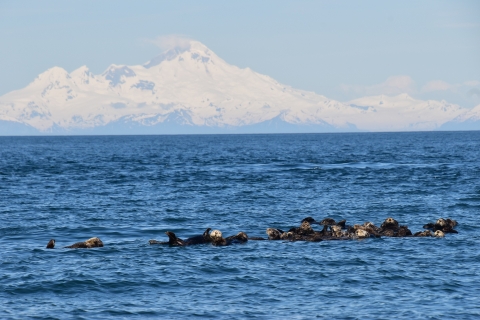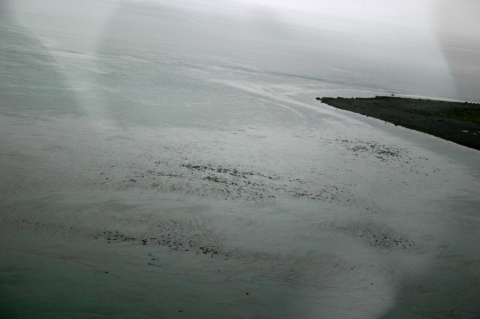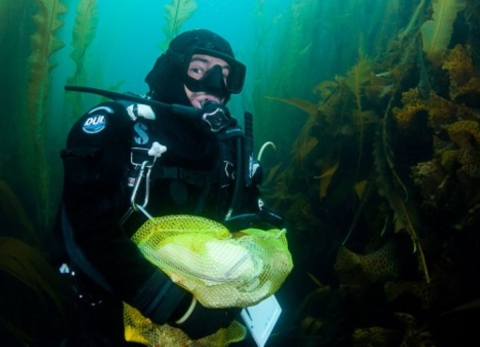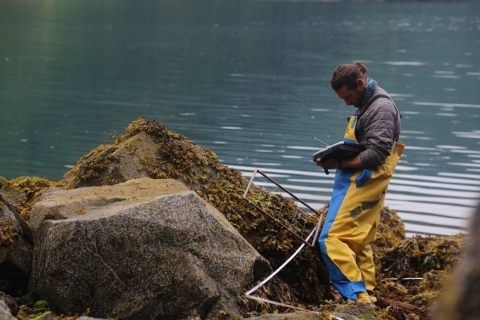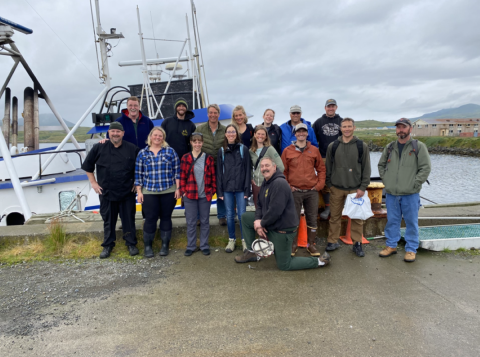Benjamin Weitzman is a wildlife biologist, diver, and seaweed lover who has experience working with sea otters throughout their range. He is passionate about coastal ecosystems with a particular interest in sea otters and their influence as a keystone species. Benjamin has benefited from collaborations across a diverse group of scientists studying ecology through the north Pacific, contributing to countless projects and recently published research. The USFWS Library is celebrating Service scientists who are committed to science excellence and the work of conservation through the FWS Scholar series.
Sea otters are a keystone species, which means they can have big impacts on how the entire ecosystem functions. Not only are they cute and sociable animals, but sea otters are ecosystem engineers that thrive in nearshore habitats and forage on various clams, urchins, and snails. Because their prey can devour entire kelp forests and alter other nearshore habitats, sea otters are necessary to maintain the balance of the ecosystem. Without sea otters as a top predator, sea urchins can dominate the sea floor and diminish the lush kelp forests that provide cover and food for many aquatic species. Read on to see how Benjamin’s research offers new perspectives that will open more opportunities to greater coexistence between people and sea otters in the future.
Benjamin currently lives in Anchorage, Alaska, and gets to work and play across the beautiful state of Alaska, one of the first places he put down roots. When he was young, his family moved around a lot, teaching him flexibility and adaptability to a changing environment. Benjamin graduated from his third high school and began a bachelor’s degree in marine biology at University of California (UC) Santa Cruz, where he spent much of his time volunteering at Long Marine Laboratory as an animal trainer with dolphins, sea lions, and sea otters to support research and conservation of wild populations. Benjamin’s diving and sea otter handling experience led to a job with California Department of Fish and Game as a sea otter capture diver when he graduated.
With those skills, he went to work for the U.S. Geological Survey (USGS) as a wildlife biologist participating in research through out the sea otter range, mostly in Alaska, examining how sea otters and their nearshore habitats are changing over time. The historical global population of sea otters, likely numbering 150,000 to 300,000 otters, had been reduced to fewer than 2,000 animals by the end of the 19th century. Since that time, sea otters have recovered to a range-wide total of approximately 130,000 sea otters, the majority of which reside in Alaska. Humans severely altered marine ecosystems of the north Pacific by removing sea otters. There are still many threats to sea otters from humans, such as illegal harvest, entanglement in fishing gear, boat strikes, and oil spills.
Benjamin expresses, “It is exciting to be part of a generation learning how to coexist with sea otters as they return to their historic range.” While working with USGS, Benjamin obtained a master’s degree from UC Santa Cruz looking at sea otter impacts on intertidal clams and mixed-sediment habitats. He continued his academic journey, while still working with USGS, and completed a PhD from the University of Alaska Fairbanks examining sea urchin ecology across the Aleutian Archipelago since the collapse of the sea otter population.
Benjamin briefly worked as an ecologist with National Oceanographic and Atmospheric Administration (NOAA) National Centers for Coastal Ocean Science out of Homer, Alaska. Currently, he works for the Alaska Marine Mammals Management Office as a wildlife biologist in the Sea Otter Program. This role allows Benjamin to continue pursuing his academic journey of working with coastal ecosystems and sea otters.
Predator-prey interactions fascinate Benjamin, and he was first drawn to studying sea otters after reading an article about their interactions with killer whales resulting in changes to kelp forests and the surrounding ecosystem. That spark has been part of his own research, having contributed to contemporary works that build on some of those seminal pieces. His most recent articles include, “Changes in Abiotic Drivers of Green Sea Urchin Demographics following the Loss of a Keystone Predator” and “Sea otter population collapse in southwest Alaska: Assessing ecological covariates, consequences, and causal factors.” He explains, “These efforts used a long-term dataset of sea urchins and kelps from across Alaska to understand the functionality of sea otters over time, in terms of top-down control and climate change climate change
Climate change includes both global warming driven by human-induced emissions of greenhouse gases and the resulting large-scale shifts in weather patterns. Though there have been previous periods of climatic change, since the mid-20th century humans have had an unprecedented impact on Earth's climate system and caused change on a global scale.
Learn more about climate change resilience, and support recovery of the ESA-listed southwest stock of northern sea otters.”
By participating in several long-term monitoring efforts, Benjamin has gained insights into drivers of change in marine ecosystems. He serves as an investigator on the Gulf Watch Alaska Nearshore Monitoring Program. With this effort, Benjamin works within a large collaborative team to document how large-scale changes, like the Pacific Marine Heatwave and Sea Star Wasting epidemic, have altered the structure and function of nearshore habitats, and how consumers like the sea otter, may be responding. Read his recently published articles titled, “Changes in Rocky Intertidal Community Structure During a Marine Heatwave in the Northern Gulf of Alaska” and “Evidence of increased mussel abundance related to the Pacific marine heatwave and sea star wasting.” Benjamin adds, “Long-term monitoring programs provide invaluable perspective on trends over time and help set an understanding of shifting ecological baselines.”
Benjamin says, “In Southeast Alaska, sea otters and humans are walking a tight-rope of conflict and coexistence.” New research and management approaches are using cutting-edge statistical tools to inform how sea otter populations and the shellfish prey are changing over time. As seen in the article titled, “Revealing the extent of sea otter impacts on bivalve prey through multi-trophic monitoring and mechanistic models” as well as a recent report on Northern Sea Otter Population Abundance and Distribution across Southeast Alaska Stock. He explains, “With my new position at USFWS, we recently completed a full survey of the southeast Alaska sea otter stock, which provides valuable information to understanding how sea otters and their ecosystems are changing over time. These fresh perspectives will hopefully open doors to greater coexistence between people and sea otters going forward.”
The results of these studies inform Benjamin’s current research priorities at Marine Mammals Management. He says, “I find great reward in seeing tidbits of research done by colleagues which contributes to the conservation of sea otters and nearshore ecosystems. I take pride in being able to work as a public-servant scientist, getting to collect data and share the information to the benefit of all people is a very fulfilling aspect of agency work and I am grateful to play a role in stewarding natural resources for generations to come.”
To better understand sea otters and nearshore habitats, view Benjamin Weitzman’s full list of published research. To learn more about Benjamin's career journey listen to him share on the My Life, Wildlife podcast. If you are a USFWS employee who has recently published peer-reviewed scientific literature and would like to share your research with others and be recognized as an FWS Scholar, let us know at library@fws.gov. #WeAreUSFWS


